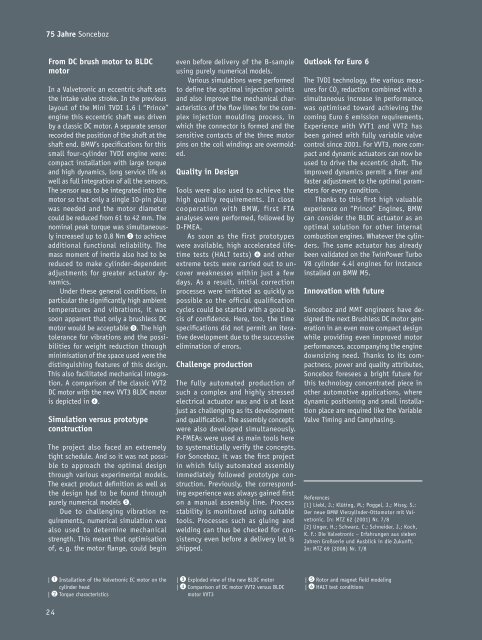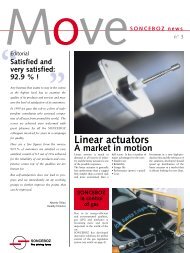75 Jahre Sonceboz 75 years Sonceboz
75 Jahre Sonceboz 75 years Sonceboz
75 Jahre Sonceboz 75 years Sonceboz
Erfolgreiche ePaper selbst erstellen
Machen Sie aus Ihren PDF Publikationen ein blätterbares Flipbook mit unserer einzigartigen Google optimierten e-Paper Software.
<strong>75</strong> <strong>Jahre</strong> <strong>Sonceboz</strong><br />
From DC brush motor to BLDC<br />
motor<br />
In a Valvetronic an eccentric shaft sets<br />
the intake valve stroke. In the previous<br />
layout of the Mini TVDI 1.6 l “Prince”<br />
engine this eccentric shaft was driven<br />
by a classic DC motor. A separate sensor<br />
recorded the position of the shaft at the<br />
shaft end. BMW’s specifications for this<br />
small four-cylinder TVDI engine were:<br />
compact installation with large torque<br />
and high dynamics, long service life as<br />
well as full integration of all the sensors.<br />
The sensor was to be integrated into the<br />
motor so that only a single 10-pin plug<br />
was needed and the motor diameter<br />
could be reduced from 61 to 42 mm. The<br />
nominal peak torque was simultaneously<br />
increased up to 0.8 Nm ❷ to achieve<br />
additional functional reliability. The<br />
mass moment of inertia also had to be<br />
reduced to make cylinder-dependent<br />
adjustments for greater actuator dynamics.<br />
Under these general conditions, in<br />
particular the significantly high ambient<br />
temperatures and vibrations, it was<br />
soon apparent that only a brushless DC<br />
motor would be acceptable ➌. The high<br />
tolerance for vibrations and the possibilities<br />
for weight reduction through<br />
minimisation of the space used were the<br />
distinguishing features of this design.<br />
This also facilitated mechanical integration.<br />
A comparison of the classic VVT2<br />
DC motor with the new VVT3 BLDC motor<br />
is depicted in ❹.<br />
Simulation versus prototype<br />
construction<br />
The project also faced an extremely<br />
tight schedule. And so it was not possible<br />
to approach the optimal design<br />
through various experimental models.<br />
The exact product definition as well as<br />
the design had to be found through<br />
purely numerical models ❺.<br />
Due to challenging vibration requirements,<br />
numerical simulation was<br />
also used to determine mechanical<br />
strength. This meant that optimisation<br />
of, e. g. the motor flange, could begin<br />
even before delivery of the B-sample<br />
using purely numerical models.<br />
Various simulations were performed<br />
to define the optimal injection points<br />
and also improve the mechanical characteristics<br />
of the flow lines for the complex<br />
injection moulding process, in<br />
which the connector is formed and the<br />
sensitive contacts of the three motor<br />
pins on the coil windings are overmolded.<br />
Quality in Design<br />
Tools were also used to achieve the<br />
high quality requirements. In close<br />
cooperation with BMW, first FTA<br />
analyses were performed, followed by<br />
D-FMEA.<br />
As soon as the first prototypes<br />
were available, high accelerated lifetime<br />
tests (HALT tests) ❻ and other<br />
extreme tests were carried out to uncover<br />
weaknesses within just a few<br />
days. As a result, initial correction<br />
processes were initiated as quickly as<br />
possible so the official qualification<br />
cycles could be started with a good basis<br />
of confidence. Here, too, the time<br />
specifications did not permit an iterative<br />
development due to the successive<br />
elimination of errors.<br />
Challenge production<br />
The fully automated production of<br />
such a complex and highly stressed<br />
electrical actuator was and is at least<br />
just as challenging as its development<br />
and qualification. The assembly concepts<br />
were also developed simultaneously.<br />
P-FMEAs were used as main tools here<br />
to systematically verify the concepts.<br />
For <strong>Sonceboz</strong>, it was the first project<br />
in which fully automated assembly<br />
immediately followed prototype construction.<br />
Previously, the corresponding<br />
experience was always gained first<br />
on a manual assembly line. Process<br />
stability is monitored using suitable<br />
tools. Processes such as gluing and<br />
welding can thus be checked for consistency<br />
even before a delivery lot is<br />
shipped.<br />
Outlook for Euro 6<br />
The TVDI technology, the various measures<br />
for CO 2<br />
reduction combined with a<br />
simultaneous increase in performance,<br />
was optimised toward achieving the<br />
coming Euro 6 emission requirements.<br />
Experience with VVT1 and VVT2 has<br />
been gained with fully variable valve<br />
control since 2001. For VVT3, more compact<br />
and dynamic actuators can now be<br />
used to drive the eccentric shaft. The<br />
improved dynamics permit a finer and<br />
faster adjustment to the optimal parameters<br />
for every condition.<br />
Thanks to this first high valuable<br />
experience on “Prince” Engines, BMW<br />
can consider the BLDC actuator as an<br />
optimal solution for other internal<br />
combustion engines. Whatever the cylinders.<br />
The same actuator has already<br />
been validated on the TwinPower Turbo<br />
V8 cylinder 4.4l engines for instance<br />
installed on BMW M5.<br />
Innovation with future<br />
<strong>Sonceboz</strong> and MMT engineers have designed<br />
the next Brushless DC motor generation<br />
in an even more compact design<br />
while providing even improved motor<br />
performances, accompanying the engine<br />
downsizing need. Thanks to its compactness,<br />
power and quality attributes,<br />
<strong>Sonceboz</strong> foresees a bright future for<br />
this technology concentrated piece in<br />
other automotive applications, where<br />
dynamic positioning and small installation<br />
place are required like the Variable<br />
Valve Timing and Camphasing.<br />
References<br />
[1] Liebl, J.; Klüting, M.; Poggel, J.; Missy, S.:<br />
Der neue BMW Vierzylinder-Ottomotor mit Valvetronic.<br />
In: MTZ 62 (2001) Nr. 7/8<br />
[2] Unger, H.; Schwarz, C.; Schneider, J.; Koch,<br />
K. F.: Die Valvetronic – Erfahrungen aus sieben<br />
<strong>Jahre</strong>n Großserie und Ausblick in die Zukunft.<br />
In: MTZ 69 (2008) Nr. 7/8<br />
| | ❶ Installation of the Valvetronic EC motor on the<br />
cylinder head<br />
| | ❷ Torque characteristics<br />
24<br />
| | ❸ Exploded view of the new BLDC motor<br />
| | ❹ Comparison of DC motor VVT2 versus BLDC<br />
motor VVT3<br />
| | ❺ Rotor and magnet field modeling<br />
| | ❻ HALT test conditions



